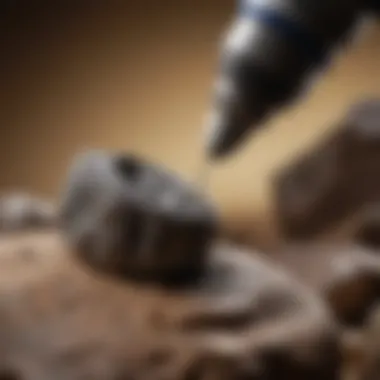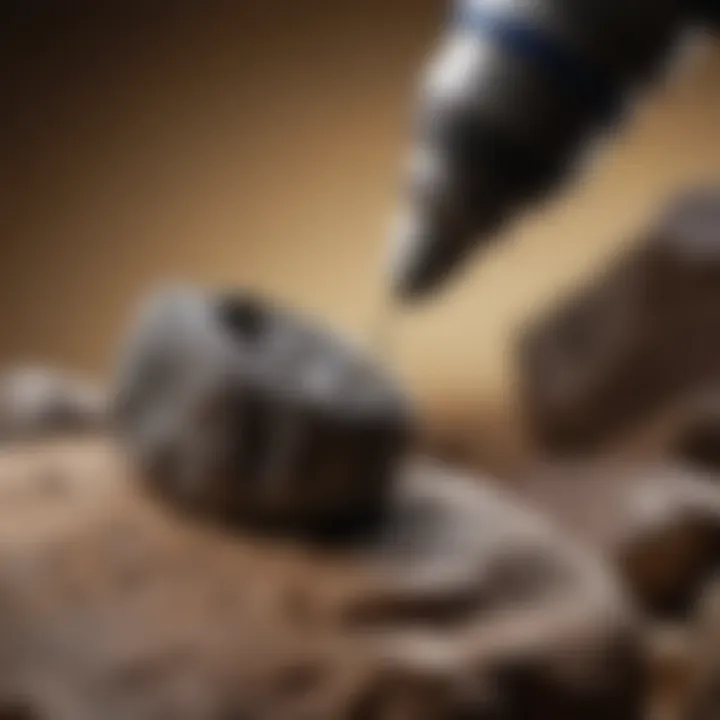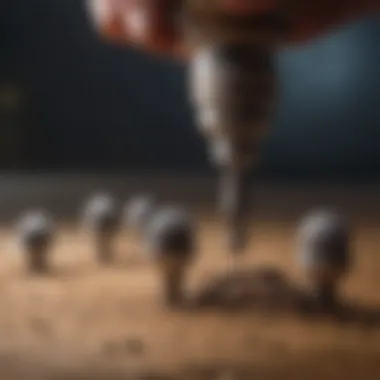Choosing the Best Dremel Bits for Rock Polishing


Intro
When it comes to rock polishing, selecting the most suitable Dremel bit can significantly impact your results. The right tools allow for a superior finish and can enhance the natural beauty of rocks and minerals. This guide aims to provide both newcomers and seasoned hobbyists with the insights necessary to navigate the diverse array of Dremel bits available.
Within this article, we will explore various Dremel bit types, each tailored for specific applications in rock polishing. We will analyze their features and performance while considering factors such as rock type and desired finish.
Featured Collectible of the Month
- Overview
The featured collectible showcases a unique rock that demonstrates exceptional polishing potential. By understanding the qualities of this rock, hobbyists can gain deeper insight into what to look for in their own collections. - Historical Significance
This collectible has roots in geological history, providing an example of how natural processes create beautiful materials that enthusiasts desire to enhance further.
Types of Dremel Bits for Rock Polishing
Dremel tools are highly versatile, and their bits come in various shapes and materials. Each type serves a specific purpose in the polishing process. Some popular types include:
- Diamond Bits
These are some of the best options for hard materials. The diamond coating aids in achieving a fine polish. - Carbide Bits
Ideal for initial grinding, carbide bits remove material effectively, preparing the stone for finer polishing. - Polishing Wheels
Made of soft materials, these attach to the Dremel and are used for the final polish, enhancing the rock's luster.
Factors to Consider When Choosing Dremel Bits
Understanding the rock's hardness will help in selecting the right bit. Here are some key factors:
- Rock Type: Softer stones may require less abrasive bits while harder stones need more powerful options.
- Desired Finish: Determine if you want a rough finish or a high gloss.
- Bit Shape: The shape of the bit can influence the polishing approach. Different shapes are suited for various crevices and contours.
Tips for Effective Polishing Techniques
To achieve optimal results, take a systematic approach to polishing. Consider these techniques:
- Start with Coarse Grit: For initial shaping, begin with more abrasive bits. Gradually move to finer bits as you progress.
- Use Water: Lubricating the surface with water can help reduce dust and improve the polishing quality.
- Patience is Key: Rushing through the process can lead to subpar results. Take your time to achieve the best finish possible.
"The key to excellent rock polishing lies in the careful selection of tools combined with methodical techniques."
With thoughtful consideration of these factors and an understanding of the tools available, hobbyists can enhance their rock polishing experience significantly.
Prelude to Rock Polishing
Rock polishing is a meticulous process that transforms rough stones into smooth, shiny specimens. This art requires not only patience but also the right tools. Choosing the right bit for your specific stone type is crucial. The proper Dremel bit can significantly enhance the polishing process, leading to optimal results. Understanding the nuances of rock polishing will help hobbyists make informed choices.
The Art and Science of Rock Polishing
Rock polishing combines both artistic and scientific elements. The artistry lies in envisioning how a rock's natural beauty can be enhanced. It involves techniques that vary from gently applying abrasives to using high speeds for a fine finish. Scientifically, the process hinges on understanding the hardness and composition of different rock types. Knowledge about minerals can direct one to the suitable abrasives and methods needed for effective polishing.
Each rock type responds differently to polishing. For instance, softer stones might require less aggressive polishing, while harder gemstones like granite demand more robust tools. Utilizing the right tools and techniques can bring out colors and patterns buried beneath rough exteriors.
Importance of Choosing the Right Tools
Selecting the correct tools for rock polishing is vital for achieving the desired finish. Dremel tools, with their variety of bits, serve as a versatile option for both beginners and experienced collectors. Different bits serve distinct purposes. Some are designed for rough shaping, while others excel in achieving the final polish.
Using the wrong tool can lead to unsatisfactory results or damage to the rock. The importance of aligning the bit with the rock's hardness cannot be overlooked. Therefore, understanding the unique characteristics of the Dremel bits is essential. It provides collectors with the capability to adapt their approach based on the specific needs of each rock type. Moreover, investing time in learning about different tools pays off with improved results and a satisfying polishing experience.
Understanding Dremel Tools
When it comes to rock polishing, understanding Dremel tools is fundamental. The Dremel rotary tool offers versatility and precision, making it a preferred choice for many hobbyists. Knowledge of the tool’s capabilities allows users to harness its potential effectively. This understanding influences the selection of appropriate bits, which ultimately affects the polishing outcome.
In particular, users should be aware of the range of models and accessories Dremel provides. Each model may have specific features, such as variable speed settings and compatibility with various attachments. Knowing the unique qualities of each tool can greatly enhance the rock polishing experience and ensure optimal results with various types of rocks.
Overview of the Dremel Rotary Tool


The Dremel rotary tool is a compact and portable device utilized for a wide array of applications. This tool can perform cutting, grinding, engraving, and polishing tasks, making it extremely versatile. Its design allows for comfortable handling and precise movements, essential in rock polishing.
Dremel tools operate at high speeds, which is particularly beneficial when working on hard materials like stone. Different models offer power variations, allowing users to choose one that best fits their needs. A rotary tool is not just about output; its maneuverability contributes to achieving smoother finishes on rock surfaces.
Key Features of Dremel Tools
Dremel tools come with several features that significantly enhance their performance:
- Variable Speed Control: This feature allows users to adjust the speed according to the specific demands of rock polishing. For soft stones, lower speeds might be ideal, while harder ones may require higher speeds.
- Ergonomic Design: Most models are designed for comfort, allowing extended use without fatigue. Comfortable grips enhance precision during polishing.
- Wide Range of Attachments: Dremel offers various bits and accessories tailored for different tasks. Selecting the right attachment can make a significant difference in polishing effectiveness.
- Durability: Dremel tools are built to withstand frequent use. Their robust construction offers longevity, especially useful for serious hobbyists.
Understanding the features of Dremel tools can help hobbyists select the right model and attachments for their specific polishing projects.
In summary, being familiar with the Dremel rotary tool and its key features is crucial for effective rock polishing. This knowledge allows users to maximize the tool's potential, thereby improving results and enhancing the overall experience.
Types of Dremel Bits for Rock Polishing
Selecting the appropriate Dremel bit for rock polishing is crucial for achieving optimal results. Each type of bit offers distinct characteristics that can influence both the efficiency of your work and the quality of the final product. Understanding the specific types of bits available helps one to make informed choices tailored to the type of rock being polished and the desired finish. This section delves into several types of Dremel bits, each with unique features that cater to different polishing needs.
Diamond Bits
Characteristics and Advantages
Diamond bits stand out for their unmatched hardness and durability. These bits are embedded with diamond particles, enabling them to tackle harder stones effectively. Their ability to maintain sharpness over extended use is a key characteristic, making them a popular choice among rock polishing enthusiasts. One significant advantage is their capability to produce a smooth finish on a variety of rock types. This makes diamond bits particularly effective for those seeking to achieve high-quality polished surfaces.
Recommended Uses
Diamond bits are best used for polishing harder materials such as agate or quartz. Their efficiency in grinding and finishing makes them a go-to for those looking to work with these tougher rocks. They excel in providing a smooth surface without significant material loss, which is essential for maintaining the rock's integrity. However, they may not be ideal for softer materials, as the abrasive nature can sometimes damage them.
Carbide Bits
Material Composition
Carbide bits are constructed from tungsten carbide, a material known for its hardness. This allows these bits to perform well on a variety of rocks, particularly those that are moderately hard. The robustness of carbide not only provides longevity but also adds to its cost-effectiveness, as they tend to last longer than other alternative bits. These bits strike a balance between durability and versatility, making them suitable for many rock polishing applications.
Best Applications
Carbide bits are ideal for shaping and grinding softer rock types like soapstone or some forms of limestone. Their adaptability to various polishing tasks is a major benefit. However, one must be cautious not to apply excessive pressure, as this can lead to wear on the bit and affect performance. Using carbide bits allows for a more controlled polish, which can be advantageous for detailed work.
Aluminium Oxide Bits
Properties of Aluminium Oxide
Aluminium oxide bits are valued for their affordability and versatility. Composed of fine aluminium oxide abrasive, they are suitable for use with softer rocks and provide a decent polish. They are not as long-lasting as diamond or carbide bits but serve as a good entry-level option for beginners. Their gentle polishing action makes them ideal for delicate tasks.
Suitable Rock Types
These bits work well on materials such as soft limestone and alabaster. They may not withstand the demands of harder stones, but for someone focused on softer rock polishing, they remain a beneficial choice. For those just beginning their polishing journey, aluminium oxide bits provide a low-risk environment to practice skills and techniques.
Ceramic Bits
Benefits of Using Ceramic
Ceramic bits offer unique properties suited for fine polishing. They provide a smooth finish while being relatively resistant to wear. The advantage of ceramic bits lies in their ability to function well at high speeds, producing excellent results with minimal heat generation. This quality makes them a favorite for intricate polishing tasks where detail is crucial.
Where to Apply
Ceramic bits are particularly effective on softer stones, much like aluminium oxide. They are well-suited for polishing delicate details in stones, allowing for precision without altering the basic structure of the rock. Users should be aware that while effective on softer materials, they might not suit harder stones well, as they may wear more quickly in such settings.


Choosing the right Dremel bit is crucial not only for the finish of the rock but also for the ease of work and longevity of the tools used.
Factors to Consider When Choosing a Dremel Bit
Selecting the right Dremel bit is crucial for effective rock polishing. There are several factors that can significantly influence the polishing process and the quality of the results. Making informed choices about Dremel bits not only maximizes efficiency but also ensures that the rocks are polished to the desired finish. A mismatch between the bit and the rock type can lead to suboptimal results or even damage. This section will outline key factors to consider when choosing a Dremel bit, helping hobbyists achieve their polishing goals.
Rock Hardness and Type
Understanding the hardness and type of the rock you are working with is an essential starting point when selecting a Dremel bit. Different rocks have varying hardness levels, and this affects how a bit interacts with the material. For instance, softer rocks like alabaster can be effectively polished with aluminium oxide bits, whereas harder stones, such as granite, require stronger diamond bits.
The hardness of a rock is measured on the Mohs scale, where talc is the softest at 1 and diamond, at 10, is the hardest. Using a bit that is not suitable for the hardness of your rock can lead to ineffective polishing or damage to the rock. Therefore, it is vital to gauge the hardness and select a compatible Dremel bit accordingly.
Bit Compatibility with Dremel Models
Another critical factor to consider is the compatibility of the Dremel bit with specific Dremel models. Dremel tools vary in their specifications and features, meaning that not every bit will fit every model. For example, some models may use a collet system that only accepts bits in certain sizes. Failing to check compatibility can lead to wasted time and frustration.
It is advisable to consult the user manual of your specific Dremel tool to understand the size and type of bits suitable for use. Keeping track of this compatibility can help streamline the polishing process and reduce downtime.
Polishing Goals and Techniques
When engaging in rock polishing, it is imperative to have a clear understanding of your polishing goals and the techniques you intend to apply. The polishing process can vary greatly depending on the desired final appearance of the rocks.
Surface Finish Requirements
Surface finish requirements are vital to achieving a high-quality polish. The clarity and smoothness desired can dictate the choice of the Dremel bit. For example, if you aim for a glossy finish on gemstones, diamond bits are often recommended due to their superior cutting ability. The advantage of focusing on surface finish is that it directly influences the aesthetic quality of the polished rock.
Opting for the right bit type to achieve your surface finish goal can enhance the shine and luster, making your polished rocks more visually appealing.
Polishing Speed Considerations
Polishing speed considerations play an equally important role in the final results of the polishing process. Different bits excel at various speeds, and understanding how speed impacts your work can lead to better finishing. Slower speeds may be preferable when polishing to prevent overheating and ensure a controlled process, whereas higher speeds can be used effectively for initial shaping or removing larger amounts of material.
Balancing speed with the correct technique ensures an efficient workflow and prevents mistakes that may occur from improper techniques.
Choosing the right Dremel bit involves careful consideration of rock type and hardness, compatibility with your tool, and your polishing objectives. Each of these factors contributes to a successful polishing experience.
Best Practices for Rock Polishing Using Dremel Bits
Rock polishing can be both a satisfying and intricate process, particularly when using Dremel tools. The right approach and practices ensure that not only are the rocks polished effectively, but also that the tools and materials used are preserved. This section emphasizes best practices that enhance the entire experience and outcome.
Preparing Your Rocks
Proper preparation of rocks is essential. Before starting the polishing process, check the rocks for any visible imperfections or dirt. Clean the rocks using water and a brush. Remove any debris that may scratch the surface during polishing. The more thorough the preparation, the better the final result will be. Furthermore, understanding the natural characteristics of the rock, such as hardness and composition, can lead to better polishing outcomes.
Setting Up the Dremel Tool
A well-configured Dremel rotary tool optimizes the polishing process. Begin by plugging in the tool and selecting the appropriate speed. Each rock type may require different speeds. Higher speeds can create more friction and heat, while lower speeds allow for more control. Ensure the chosen bit is securely attached before starting. An unstable bit can cause uneven polishing and potential accidents. Additionally, consider having an organized workspace to keep all materials and tools in one place.
Polishing Techniques
Applying the Right Pressure
When polishing rocks, applying the right pressure is crucial for effectiveness. Too much pressure can lead to uneven surfaces or even damage the rock. Conversely, too little pressure might not achieve the desired polish. Finding the balance is key. This practice ensures that the bit makes sufficient contact with the surface without causing abrasions. Understanding this aspect is beneficial for both novice and experienced users. It allows for gradual and controlled polishing for a better finish.
Maintaining Consistent Speed
Maintaining consistent speed during the polishing process contributes significantly to achieving an even surface. This approach enables uniform wear on the polishing bit, which extends its lifespan. A steady speed allows the user to maintain control and precision. Rapid fluctuations in speed can lead to unwanted results, such as uneven polishing or overheating. Keeping the speed constant helps in achieving a smooth, glossy finish.


Post-Polishing Care
Post-polishing care is just as important as the polishing process itself. Proper handling and cleaning practices can prolong the life of the Dremel bits and preserve the beauty of polished rocks.
Cleaning the Bits
Cleaning the bits after use prevents the accumulation of debris and residue, which can affect their performance. Use a soft brush and water to remove any particles caught in the grooves. This maintenance is essential as it ensures the bits remain effective for future use. Well-maintained bits can last longer and achieve better results over time, ultimately saving money and effort.
Handling Polished Rocks
Once the rocks are polished, handling them with care is paramount. Avoid touching the polished surfaces directly to prevent fingerprints and smudges. Store them in soft cloth pouches or display cases to protect the finish. Proper handling not only maintains the aesthetic quality but also safeguards against damage. This attention to detail reflects a commitment to preserving the beauty of each rock.
Common Mistakes to Avoid
In any hobby, understanding potential pitfalls can make a significant difference between success and frustration. This section identifies common mistakes made during rock polishing with Dremel tools. By being aware of these mistakes, hobbyists can avoid setbacks, enhance their skills, and ultimately achieve impressive results in their rock polishing endeavors.
Using Incorrect Speed Settings
One of the most frequent errors is not setting the Dremel tool to the appropriate speed for the task at hand. Each type of Dremel bit requires a specific speed to operate effectively. For instance, diamond bits may function optimally at different speeds compared to aluminium oxide bits. Using too high of a speed can cause overheating, leading to premature wear on the bit and damage to the rock. Conversely, a speed that is too low may prevent effective polishing, resulting in a dull surface.
To find the correct speed, enthusiasts should refer to the manufacturer’s guidelines for both the Dremel tool and the specific bit being used. Experimenting with various speeds, while keeping a close eye on the results, can help establish a routine that maximizes efficiency.
Neglecting Safety Precautions
Safety is paramount when using a Dremel tool for rock polishing. Many hobbyists underestimate the hazards associated with this activity. When working with abrasive materials, fine dust and particles can be released into the air. This can pose respiratory risks and potential eye injuries.
Proper safety measures include:
- Wearing safety goggles to protect your eyes from dust.
- Using a dust mask to filter out particulate matter.
- Handling tools carefully to avoid cuts or injuries.
Creating a safe workspace is vital. Ensure that the area is clean and well-ventilated. Proper safety protocols will not only protect the person polishing but also enhance focus and productivity.
Not Testing on Sample Rocks First
Another regrettable mistake is neglecting to test Dremel bits on sample rocks before working on a valuable piece. Each rock exhibits unique characteristics, such as hardness and composition, which impact how polish is applied. Testing on sample rocks allows users to gauge how different bits perform. It also helps in understanding the effects of pressure and speed settings.
Before starting on a significant piece, take the time to:
- Select a similar, less valuable rock.
- Test various bits and speeds.
- Observe the results carefully.
This practice not only fosters familiarity with the tools but also significantly reduces the risk of damaging cherished specimens.
"Learning from others' mistakes can save time and resources; the goal is to perfect the process and celebrate each polished rock you create."
By understanding and avoiding these common mistakes, rock polishing can evolve from a challenging task into a rewarding hobby. Knowledge about correct operating procedures is indispensable for honing skills and achieving exceptional results.
Closure and Final Thoughts
In the realm of rock polishing, selecting the right Dremel bit can profoundly influence the outcome of your project. The choice of bit impacts not only efficiency but also the overall quality of the polished stone. Understanding the various specifications of each bit type—be it diamond, carbide, or ceramic—ensures that hobbyists can match their tools to the specific characteristics of the rocks they are working with.
Moreover, the detailed exploration of factors to consider helps in making informed decisions. From hardness levels to compatibility with various Dremel models, each consideration plays a critical role. By grasping these nuances, both novice and experienced polishers can tailor their approach to achieve desired results more effectively.
Ultimately, the choice of the right Dremel bit elevates the satisfaction of polishing. A well-polished rock speaks volumes about the skill and knowledge of the person behind it. This article underscores the importance of education in the art of rock polishing, encouraging every reader to refine their technique and tools to foster improvement.
Recap of Key Points
- Understanding Dremel Bits: Various bit types have unique properties suited for different polishing techniques.
- Choosing Appropriately: Factors like rock hardness and desired finish shape your decision.
- Best Practices: Following best practices in the setup can prevent common mistakes and enhance the polishing experience.
- Continuous Learning: The journey of mastering rock polishing is ongoing. Knowledge gained through trial and error enhances skill over time.
Encouragement for Continuous Learning
Polishing rocks is more than just a hobby; it is a true artistic endeavor that deserves dedication and precision. Each polishing session presents an opportunity to learn and improve. Embracing mistakes as learning experiences will foster deeper knowledge about tools and techniques.
Engaging with communities such as those found on Reddit or Facebook can also provide valuable insights. Experimenting with different Dremel bit types in various conditions will deepen your understanding of their unique uses. As the field of rock polishing continues to evolve, staying informed about new techniques and tools opens doors for advancement.



